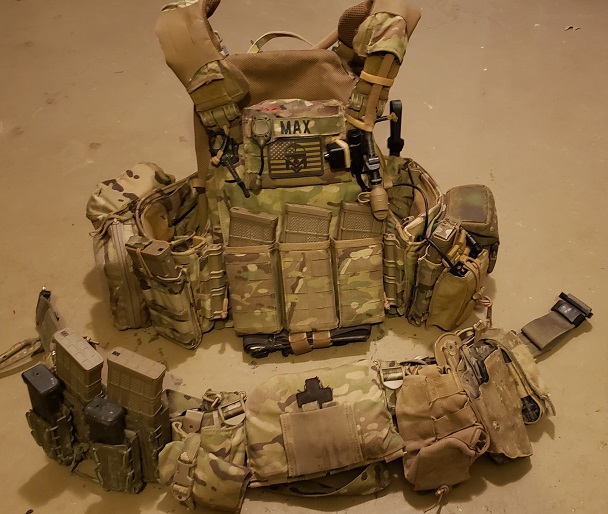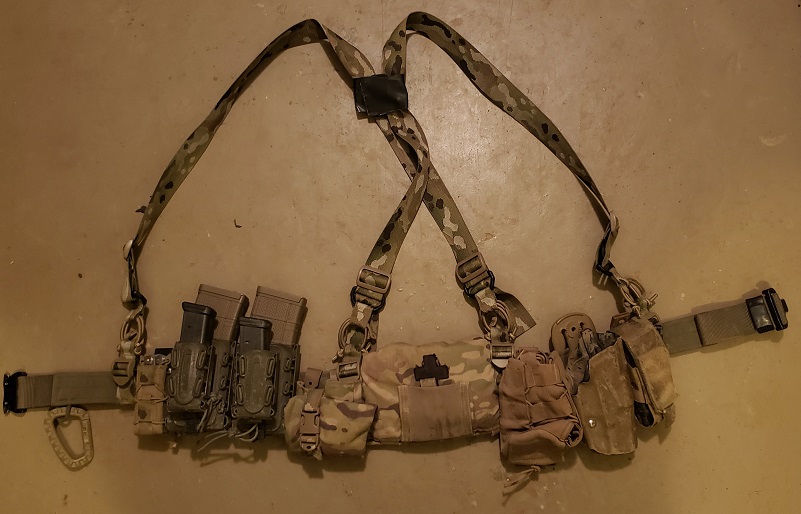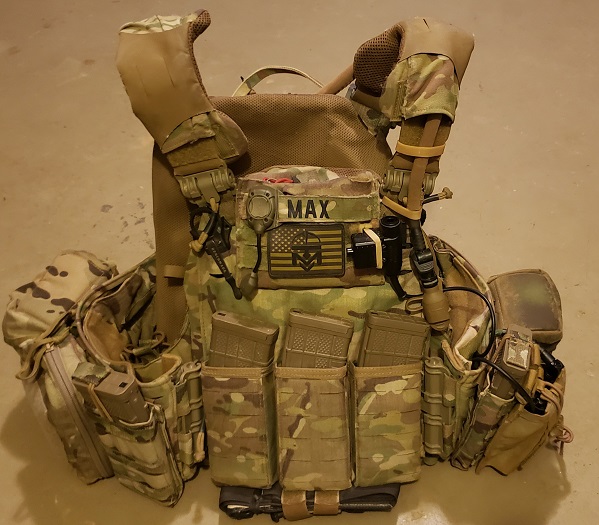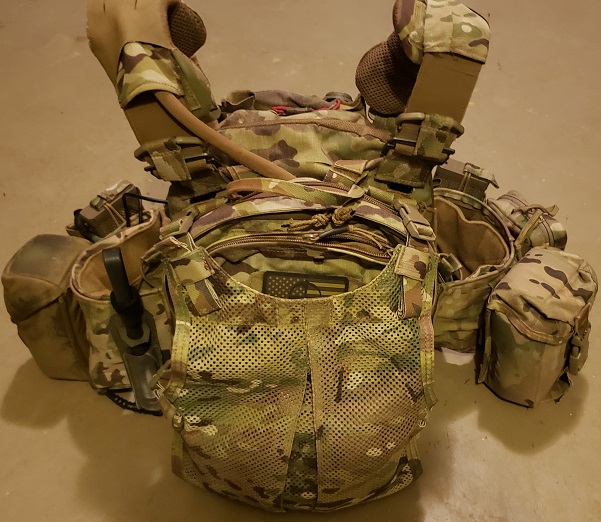The Practical Application of Tactical Gear, Load & Weight Considerations

This is a repost, updated.
The intent of this post is to tie in the related concepts of tactical gear, fitness, teamwork, logistics and tactical loading, in order to present a realistic and logical way to approach the subject.
There are a number of related factors at play here:
Mission: We often utilize the military terminology of ‘METT-TC’ in order to analyze our mission and thus apply it to the gear that we may carry. Factors such as weather, duration and the specific mission that you are conducting all play into considerations of what to carry. We must be realistic in what we plan and train for now, and thus pack for, based around what we think we realistically might be doing in a collapse situation. I put it to you that most people will be engaged in local defense, security patrolling, and perhaps presence / ground domination activity (GDA) patrolling in and around their homestead and perhaps local community; thus not multi-day ruck-missions out into the boondocks. This has relevance as we examine the other factors.
Logistics: However much you pack, you will ultimately need a resupply. Many people with a ‘prepper’ mindset want to pack too much ‘just in case’ they need it. I would advise a different approach, one where you plan for that resupply and set up a logistics chain. If it allows you the ability to maneuver under fire, it would be better to have to temporarily make do without something, than carry a huge load. Thus you could consider something along the lines of planning to utilize vehicles such as trucks, ATV/UTV’s, and even perhaps horses or mules to support any mission that you plan that you suspect will go beyond one days rations / one first line ammunition scale (i.e. what is realistically carried on the person as part of a deployed load-out). This also ties in very well with casualty evacuation. I tell people at class that the hardest thing they will do is evacuate a casualty under fire. So much so that I propose that with today’s typical weight of person measured against poor levels of physical fitness, factoring in the exhaustion of being under fire, many casualties will not be evacuated, or at least not evacuated far. Thus, in a break contact drill, this means they will be left, or the team will be forced to strongpoint, in order to call for QRF / casualty evacuation. For this, you need communications, an actual QRF (trained and rehearsed team) and suitable transport for them to deploy to you and extract you.
Tactical Load: You should only carry what you can fight in; by which I mean maneuver under fire. Much has been said about 55lb being the maximum that a person can carry into combat, but we must remember that 1) the person must be fit and robust in the first place to manage this, and 2) this refers to weight that can be carried in on an approach march, not actually fought in. In order for the individual to be able to maneuver tactically under fire, this load must be reduced. For example, I would consider 35lb as a much more practical load weight that 55lb. This however may not include the weight of the rifle; your mileage may vary. This goes directly against carrying all that stuff that you want to carry because ‘two is one and one is none,’ and relates to the concept of logistics. An individual should not be loaded out with, for example, 16 magazines on the person, plus whatever else. They should be loaded with something more like 6-8 mags depending on the mission, with a support team moving resupply up in an ATV. “No man is an island” and you cannot fight everyone forever on your own – you can only carry a limited amount and still remain effective, and then you need resupply.
Physical Conditioning: None of these factors mean anything without the physical conditioning to carry your load and maneuver under fire. Given that many suffer from age, obesity, lack of training, injuries and medical conditions, it really does reap benefits to take a more ‘light fighter’ approach and plan to be without, rather than be with, too much. You probably do not need all those widgets and extras. There are some things that it is really sensible to carry, and that detail is beyond this article . But you cannot carry ALL that water, ammo and food, so you need to balance the needs of realistic short term missions with arranging resupply. Tied to this, is the activity of ‘rucking.’ I really do not think that anyone should be planning to do anything while carrying a ruck. Get away from the idea of ‘bug out rucks’ and all that. It is possible that you may have to carry a ruck on an approach march to set up a patrol base, but how likely is that given the missions that you may be conducting? You will also have to drop that ruck at the first contact and may likely never see it again. I posit that you are more likely to be doing relatively short term missions, if you go anywhere at all outside of an envelope of more than a mile or so from your home base. Thus, get away from heavy ‘rucking’ as training. I would advise that you train where possible with your actual tactical load-out gear, weighing around 35lb. The training value of carrying a ruck is more relevant to situations where for profile purposes, you cannot, or do not want to, go out wearing tactical gear. So then you pack a ruck to replace that for training purposes – but carry no more than 35lb in that ruck, which is a realistic combat load weight that you can use for training purposes. Alternatively, use a weighted vest, which is ergonomically similar to your plate carrier load weight.
Transport: As part of logistics, you need to consider the use of vehicles, such as ATVs. I was recently in Idaho running classes and we were using ATVs as resupply logistics vehicles out on the open range. Rather than plan to carry a large ruck or patrol pack, simply wear the load that you can maneuver and fight in, and put the rest on the ATV. The ATV can actually move with the patrol, particularly in large open spaces, with low engine noise caused by low revs, and simply stay a terrain feature away from the objective. Then, when called for, the support vehicles(s) move up to the objective, and trade ammo / water resupply for any casualties. This in itself gets into a mobility question, with the use of tactically suitable vehicles such as off-road trucks, ATV/UTV and other transport to provide tactical mobility. So you can either move transport with dismounts, or mount the dismounts to get them closer to the objective area. Transport stays at the Objective Rally Point (ORP) until called for. (Mission Support Site (MSS) for those who want to be really contemporary).
Ballistic Plates: Although plates add weight, we all realize that although we want to be light, we will never be totally free of carried weight if we are going to carry a combat load. Thus, we plan to be AS LIGHT AS PRACTICABLE. We have to carry a certain amount of ammo, of water, IFAK, basic rations etc. In my opinion, ballistic plates are worth the added weight, in the balance. Reducing the chances of penetrating trauma to the torso / thoracic cavity is important in my mind, particularly given what I said above about casualty evacuation. BUT: you cannot carry plates if you have not achieved the conditioning to allow you to do so, and move tactically with them on. The flip side is that if you have a logistics plan, you can dump some of those widgets and extra magazines you wanted to carry, and allow yourself plates. It is all a balance of FIREPOWER, PROTECTION and MOBILITY. The key thing with plates is to buy ‘Level 3+’ ceramic / dyneema hybrids that are light but will stop M855 Green Tip. III+ is not an official NIJ standard but they are sold. My plates weight 3.8lb each. (These are ShotStop plates, for which I am a dealer (see the MVT Store), and are the 10×12 GT2 plates). That to me is a trade-off that is worth it. If you do not have the conditioning, and if you have super heavy plates, you will not wear them anyway, not beyond 24-hours after the collapse happens.
A Note on plates: please get away from steel, and more accurately, please get away from the concept of only having plates, such as heavy steel plates, for defensive purposes. Because you want to buy heavy cheap plates, but you do not want to invest in the physical training to be able to maneuver with them on. In fact argumentatively, defensively, you are less likely to need plates if you are using prepared fighting positions. You are more likely to need them if you come under fire while on patrol, or in an offensive dynamic operation. Thus, when considering plates, consider ones that you can practically wear and fight in.
Team: In order to be able to conduct any sort of patrolling / security operation, you are going to need a team. This means numbers of trained personnel. You cannot have that QRF if you do not have the trained bodies to man the operations center and the QRF team, while also running a security rotation on your home base. Thus, it goes without saying that you need trained people, in sufficient numbers, to provide an effective tactical team.
Combat Load: so what do you carry? The point is that you have to balance the logistics of what you carry on your body, with what you can effectively maneuver around in. Thus, physical condition and strength must increase, while the load must come down to something that you can tactically maneuver in. You have to be able to be comfortable wearing this gear. Particularly if a collapse goes on for a time, and complacency starts to rear its head, you have to have a practical plan that allows you to be wearing some gear, and also be ready and comfortable for long periods of time.
The MVT Gear Concept:
1) Day to day now you are probably wearing some sort of concealed carry around your waistline. It is thus not practical to rapidly don something over the top of that, such as a Battle Belt, without dismounting your IWB handgun setup. Thus, in semi-normality when there is a sudden threat, once you can get to your rifle you pair it with either a chest rig or a plate carrier setup. I prefer to have a plate carrier, and for maneuverability you need to keep the magazine load on that rig reasonable, so somewhere between 3 – 6 magazines on the chest rig / plate carrier depending on what you are doing and the intersection of your conditioning and strength levels vs. the weight.
2) Once we reach a situation where we have deteriorated beyond normal concealed carry, you want to be able to reasonably feed your rifle with magazines. This is where the concept of the ‘Lite Battle Belt’ comes in. My version is a battle belt that goes on over my pants belt. Suspenders are optional: I never want the belt to become such a large heavy object that it needs them, and for the longest time paired the lite battle belt with an inner velcro belt, which held it well. More recently, I put light-weight suspenders on the battle belt. It is designed to be comfortable and wearable all day, while providing a decent level of basic logistics support. I can also sit in a chair or drive a vehicle comfortably while wearing it. From the left it contains):

- 2 x handgun magazines (mounted on the outside of the rifle magazines).
- 2 x rifle magazines.
- rolled dump pouch.
- IFAK pouch, center of back.
- Bottle pouch – for small water bottles, for a short term hydration capability, often used on the ranges.
- Holster.
- TQ pouch.
- Multitool pouch.
Thus this belt provides a basic load that you can go walking around in, with your rifle, and have some reloads and logistical support available. I personally wear this on the ranges, whenever doing ‘tactical stuff,’ and for hikes with my rifle (plus plate carrier and / or sandbag). It provides the basic load with my plate carrier, and between the Lite Battle Belt and the Plate Carrier, supplies me with my basic load.
3) Plate Carrier or Chest Rig: I am using a First Spear Assaulter Plate Carrier. I do have access to chest rigs, but given everything I have said so far in this post, I am going with the plate carrier. This plate carrier includes:
- 5 Magazines.
- TQ.
- Tactical Light (mounted front of plate carrier).
- Radio – GT 3WP with Peltor PTT / antenna routed to rear of carrier.
- Spare radio battery.
- FLIR
- Night vision.
- Rations (emergency bar-type on the go rations).
- TQ.
- Hydration.
- Compass.
- Emergency self-defense knife.
- Batteries.
- Additional admin stuff in backpack i.e. cleaning rod etc.
- ShotStop 10×12 GT2 Plates (3.8lb per plate).
- First Spear comfort plate backers – for sweat etc.
Note: not pictured is my helmet. This is part of the Lite Fight concept and should be worn in any kinetic environment. Mine is set up for night vision and has Peltor ear-pro attached.

I see many people wearing plate carriers, minimally loaded. They have either given no thought to the duration of possible patrols, or expect to be next to their truck the whole time. For example, the reason I carry FLIR and night vision on my kit (you can also carry in a small backpack, your choice) is for practical reasons. At dawn or dusk you will need to pause activity and mount /dismount your night vision gear. Thus you need to have it with you. The purpose of the FLIR (on my kit) is for scanning of the next movement bound (day or night), prior to moving over it. FLIR is amazing for picking up any activity that you may not have seen with either naked eye, or with night vision.
For an excellent resource for optics and night vision, check out JRH Enterprises, run by a long-term MVT Alumnus, Robert.
4) Hydration Small Pack: It carries 2-3 liters of water and has a couple of pouches for some miscellaneous gear, some lunch, maybe my night vision gear, and a couple of additional mag pouches on the back. The idea of this is that you would grab it for anything out of sight of your home base. You can use any suitable small pack for this, the trick is to use a small pack that prevents you packing too much, but allows the basics to be carried. Note: I have recently gone to a zip-on pack on the rear of my plate carrier (Tyr Tactical Pack, held on by Tyr Tactical MOLLE zippers). Lots of pros and cons here 1) there is less ‘strappage’ to deal with, and the pack is comfortable 2) I can only access the pack if I take off my plate carrier, or ask a buddy.

5) Lite Patrol Pack: Something around 30 liters capacity. If your mission requires you to carry more of a load, then this is what you go to. I have no intention of going bigger than this, to a full ruck. Reasons for a larger Patrol Pack include weather and duration considerations. I will, however, try to plan the heavy loads out of it. Note: I have to unzip my assaulter pack / hydration bladder from the back of my plate carrier, if I want to carry a backpack.
Crucial Points to Note:
Once we get to the point of wearing the Battle Belt, the Plate Carrier and the Hydration Small Pack, we are reaching the limits of what most people, with some physical conditioning, can effectively tactically maneuver in. You want to try and keep load at this level and not above. You have to make your own choices with the specifics of what you carry, number of magazines, ballistic plates or not, etc.
You have to make the judgment, at the intersection of weight and physical capability, of what you can really do. Thus you have to get out and train in this gear, to really know your limits and capabilities. Ballistic Plates may not always be an option for you. As the collapse draws out in the heat of summer, and you are conducting local security patrolling, you will have options. You could go in the Lite Battle Belt only. You could drop the Plate Carrier for a chest rig. All of this is possible and it must be practical. This is also why it is useful to have a chest rig that will clip on and off a plate carrier, or simply go on over the top of it.
Crucially, if you are carrying too much of a load, it will make you unwilling to make the right choices when you are out there. This is the intersection of physical fitness and load carried. You will avoid moving to that high ground for overwatch. You will not take a good fire position, or you will only go to a knee for cover when you should have gone prone, You have to balance the weight you carry with what you can operate in effectively without shortcuts.
Summary:
1) Plan operations intelligently.
2) Utilize logistics to reduce the load that has to be carried on the man.
3) For operations outside of your immediate home base footprint, utilize transport for:
- Ammo resupply.
- Food, water and logistics.
- Casualty evacuation.
4) Stop overloading yourself with gear that you ‘may need.’
5) Only wear a combat load that you have the physical ability to maneuver in.
6) Do the PT to reach an intersection where you can carry a sufficient basic load that makes you effective in combat.
7) Aspire to lightweight Green Tip ballistic plates to increase your survivability, if you have the conditioning to ensure they do not reduce your survivability by impairing your maneuverability. It is an intersection of fitness, load and judgment.
8) If you find yourself with a requirement for larger loads, do everything you can by planning to move that load to transport.
9) Try to keep the man only ever moving with the basic load that he can handle in combat, and work to bring resupply / casualty evacuation as needed.
